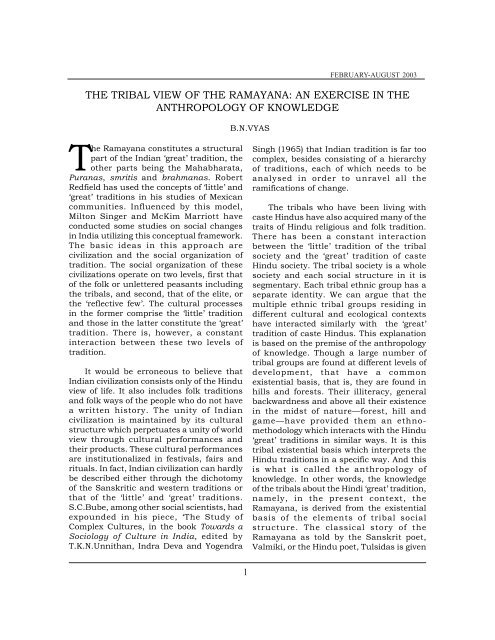Epics in Imprints-1.pdf - Vivekananda Kendra Prakashan
Epics in Imprints-1.pdf - Vivekananda Kendra Prakashan
Epics in Imprints-1.pdf - Vivekananda Kendra Prakashan
You also want an ePaper? Increase the reach of your titles
YUMPU automatically turns print PDFs into web optimized ePapers that Google loves.
1<br />
FEBRUARY-AUGUST 2003<br />
THE TRIBAL VIEW OF THE RAMAYANA: AN EXERCISE IN THE<br />
ANTHROPOLOGY OF KNOWLEDGE<br />
The Ramayana constitutes a structural<br />
part of the Indian ‘great’ tradition, the<br />
other parts be<strong>in</strong>g the Mahabharata,<br />
Puranas, smritis and brahmanas. Robert<br />
Redfield has used the concepts of ‘little’ and<br />
‘great’ traditions <strong>in</strong> his studies of Mexican<br />
communities. Influenced by this model,<br />
Milton S<strong>in</strong>ger and McKim Marriott have<br />
conducted some studies on social changes<br />
<strong>in</strong> India utiliz<strong>in</strong>g this conceptual framework.<br />
The basic ideas <strong>in</strong> this approach are<br />
civilization and the social organization of<br />
tradition. The social organization of these<br />
civilizations operate on two levels, first that<br />
of the folk or unlettered peasants <strong>in</strong>clud<strong>in</strong>g<br />
the tribals, and second, that of the elite, or<br />
the ‘reflective few’. The cultural processes<br />
<strong>in</strong> the former comprise the ‘little’ tradition<br />
and those <strong>in</strong> the latter constitute the ‘great’<br />
tradition. There is, however, a constant<br />
<strong>in</strong>teraction between these two levels of<br />
tradition.<br />
It would be erroneous to believe that<br />
Indian civilization consists only of the H<strong>in</strong>du<br />
view of life. It also <strong>in</strong>cludes folk traditions<br />
and folk ways of the people who do not have<br />
a written history. The unity of Indian<br />
civilization is ma<strong>in</strong>ta<strong>in</strong>ed by its cultural<br />
structure which perpetuates a unity of world<br />
view through cultural performances and<br />
their products. These cultural performances<br />
are <strong>in</strong>stitutionalized <strong>in</strong> festivals, fairs and<br />
rituals. In fact, Indian civilization can hardly<br />
be described either through the dichotomy<br />
of the Sanskritic and western traditions or<br />
that of the ‘little’ and ‘great’ traditions.<br />
S.C.Bube, among other social scientists, had<br />
expounded <strong>in</strong> his piece, ‘The Study of<br />
Complex Cultures, <strong>in</strong> the book Towards a<br />
Sociology of Culture <strong>in</strong> India, edited by<br />
T.K.N.Unnithan, Indra Deva and Yogendra<br />
B.N.VYAS<br />
S<strong>in</strong>gh (1965) that Indian tradition is far too<br />
complex, besides consist<strong>in</strong>g of a hierarchy<br />
of traditions, each of which needs to be<br />
analysed <strong>in</strong> order to unravel all the<br />
ramifications of change.<br />
The tribals who have been liv<strong>in</strong>g with<br />
caste H<strong>in</strong>dus have also acquired many of the<br />
traits of H<strong>in</strong>du religious and folk tradition.<br />
There has been a constant <strong>in</strong>teraction<br />
between the ‘little’ tradition of the tribal<br />
society and the ‘great’ tradition of caste<br />
H<strong>in</strong>du society. The tribal society is a whole<br />
society and each social structure <strong>in</strong> it is<br />
segmentary. Each tribal ethnic group has a<br />
separate identity. We can argue that the<br />
multiple ethnic tribal groups resid<strong>in</strong>g <strong>in</strong><br />
different cultural and ecological contexts<br />
have <strong>in</strong>teracted similarly with the ‘great’<br />
tradition of caste H<strong>in</strong>dus. This explanation<br />
is based on the premise of the anthropology<br />
of knowledge. Though a large number of<br />
tribal groups are found at different levels of<br />
development, that have a common<br />
existential basis, that is, they are found <strong>in</strong><br />
hills and forests. Their illiteracy, general<br />
backwardness and above all their existence<br />
<strong>in</strong> the midst of nature—forest, hill and<br />
game—have provided them an ethnomethodology<br />
which <strong>in</strong>teracts with the H<strong>in</strong>du<br />
‘great’ traditions <strong>in</strong> similar ways. It is this<br />
tribal existential basis which <strong>in</strong>terprets the<br />
H<strong>in</strong>du traditions <strong>in</strong> a specific way. And this<br />
is what is called the anthropology of<br />
knowledge. In other words, the knowledge<br />
of the tribals about the H<strong>in</strong>di ‘great’ tradition,<br />
namely, <strong>in</strong> the present context, the<br />
Ramayana, is derived from the existential<br />
basis of the elements of tribal social<br />
structure. The classical story of the<br />
Ramayana as told by the Sanskrit poet,<br />
Valmiki, or the H<strong>in</strong>du poet, Tulsidas is given

















